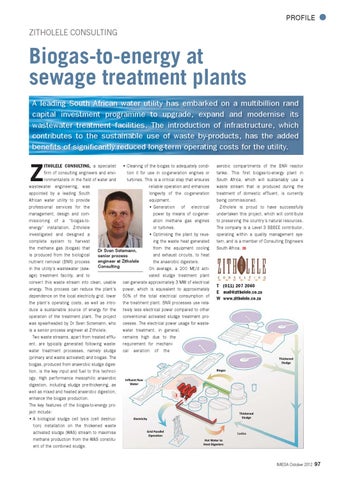PROFILE
ZITHOLELE CONSULTING
Biogas-to-energy at sewage treatment plants A leading South African water utility has embarked on a multibillion rand capital investment programme to upgrade, expand and modernise its wastewater treatment facilities. The introduction of infrastructure, which contributes to the sustainable use of waste by-products, has the added benefits of significantly reduced long-term operating costs for the utility.
Z
ITHOLELE CONSULTING, a specialist • Cleaning of the biogas to adequately condifirm of consulting engineers and envition it for use in co-generation engines or ronmentalists in the field of water and turbines. This is a critical step that ensures wastewater engineering, was reliable operation and enhances appointed by a leading South longevity of the co-generation African water utility to provide equipment. professional ser vices for the • Generation of electrical management, design and compower by means of co-genermissioning of a “biogas-toation methane gas engines energy” installation. Zitholele or turbines. investigated and designed a • Optimising the plant by reuscomplete system to har vest ing the waste heat generated the methane gas (biogas) that from the equipment cooling Dr Sven Sotemann, is produced from the biological and exhaust circuits, to heat senior process engineer at Zitholele nutrient removal (BNR) process the anaerobic digesters. Consulting in the utility’s wastewater (sewOn average, a 200 Mℓ/d actiage) treatment facility, and to vated sludge treatment plant convert this waste stream into clean, usable can generate approximately 3 MW of electrical energy. This process can reduce the plant’s power, which is equivalent to approximately dependence on the local electricity grid, lower 50% of the total electrical consumption of the plant’s operating costs, as well as intro- the treatment plant. BNR processes use relap p rela duce a sustainable source of energy for the tively t less electrical power compared to other operation of the treatment plant. The project conventional activated sludge treatment proc was spearheaded by Dr Sven Sotemann, who cesses. c The electrical power usage for wasteis a senior process engineer at Zitholele. water treatment, in general, w Two waste streams, apart from treated efflu- remains high due to the ent, are typically generated following waste- requirement for mechaniwater treatment processes, namely sludge cal aeration of the c (primary and waste activated) and biogas. The biogas, produced from anaerobic sludge digestion, is the key input and fuel to this technology. High performance mesophilic anaerobic digestion, including sludge pre-thickening, as well as mixed and heated anaerobic digestion, enhance the biogas production. The key features of the biogas-to-energy project include: • A biological sludge cell lysis (cell destruction) installation on the thickened waste activated sludge (WAS) stream to maximise methane production from the WAS constituent of the combined sludge.
aerobic compartments of the BNR reactor tanks. This first biogas-to-energy plant in South Africa, which will sustainably use a waste stream that is produced during the treatment of domestic effluent, is currently being commissioned. Zitholele is proud to have successfully undertaken this project, which will contribute to preserving the country’s natural resources. The company is a Level 3 BBBEE contributor, operating within a quality management system, and is a member of Consulting Engineers South Africa.
T (011) 207 2060 E mail@zitholele.co.za W www.zitholele.co.za
IMIESA October 2012
97
